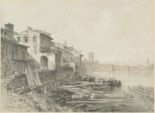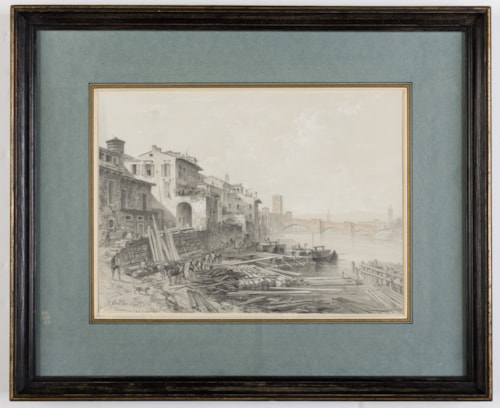Bernhard FIEDLER
(Berlin 1818 - Trieste 1904)
A View of Verona from the Banks of the River Adige, with the Ponte Scaligero
Pencil and red chalk on grey washed paper, with scratching-out.
Signed, dated and inscribed B. Fiedler. 1850 / Verona n.d. Natur gez. at the lower left.
Inlaid on an old mount.
232 x 322 mm. (9 1/8 x 12 5/8 in.)
Signed, dated and inscribed B. Fiedler. 1850 / Verona n.d. Natur gez. at the lower left.
Inlaid on an old mount.
232 x 322 mm. (9 1/8 x 12 5/8 in.)
Executed in 1850, this fine drawing by Bernhard Fiedler depicts a view of the city of Verona from the southern bank of the Adige river, near the Basilica of San Lorenzo, on what is today the Riva San Lorenzo. Fiedler is here looking west, towards the 14th century fortified bridge known as the Ponte Scaligero (or Ponte di Castel Vecchio), constructed by Cangrande II della Scala, Lord of Verona, between 1354 and 1356. (The bridge was destroyed by retreating German troops in April 1945 but was rebuilt, with original materials salvaged from the riverbed, between 1949 and 1951.) Visible at the southern end of the bridge in this drawing is the Castelvecchio castle, built by the ruling Scaligeri family between 1354 and 1376.
As the Scottish mathematician and traveller William Archibald Cadell, writing in 1820, described Verona, ‘The river Adige, which rises in the Tyrol, and has its course to the east of the Lake di Garda, runs through and nearly surrounds the principal part of the town by its winding course. The Ponte del Castel Vecchio, a bridge of three arches built over this river in 1354, in the reign of Can Grande II, is remarkable for the extent of one of its arches, which is 157 English feet in span. This bridge communicates with the castle; it is narrow, and was part of the old fortifications, and is not used for the passage of the public road.’ As another 19th century writer noted, ‘The main arch of the bridge is said to be 160 ft. wide, and instead of being in the centre, it is on the side next to the castle, and from it the other arches slope away to the north bank, in a strange down-hill kind of way.’ A third contemporary author adds that ‘The Veronese were always proud of their old bridge, whose largest arch, not in the centre, but on one side, they boast is larger than that of the Rialto.’
As the Scottish mathematician and traveller William Archibald Cadell, writing in 1820, described Verona, ‘The river Adige, which rises in the Tyrol, and has its course to the east of the Lake di Garda, runs through and nearly surrounds the principal part of the town by its winding course. The Ponte del Castel Vecchio, a bridge of three arches built over this river in 1354, in the reign of Can Grande II, is remarkable for the extent of one of its arches, which is 157 English feet in span. This bridge communicates with the castle; it is narrow, and was part of the old fortifications, and is not used for the passage of the public road.’ As another 19th century writer noted, ‘The main arch of the bridge is said to be 160 ft. wide, and instead of being in the centre, it is on the side next to the castle, and from it the other arches slope away to the north bank, in a strange down-hill kind of way.’ A third contemporary author adds that ‘The Veronese were always proud of their old bridge, whose largest arch, not in the centre, but on one side, they boast is larger than that of the Rialto.’
Active as a painter, decorator and draughtsman, Bernhard Fiedler studied at the Kunstakademie in Berlin with the landscape painters Johann Gerst and Wilhelm Krause. The recipient of an Austrian travel grant in 1843, he journeyed extensively in Northern Italy and along the Dalmatian coast, recording his travels with paintings, drawings and watercolours. Fiedler was admitted to the Accademia di Belle Arti in Venice, and spent a considerable amount of time in Trieste, producing topographical drawings of the castles of the Friuli region for King Friedrich Wilhelm IV of Prussia and serving as drawing master to the Archduchess Charlotte. In 1853 he accompanied an Austrian delegation to Constantinople, where he presented a painting to the Sultan, and the following year was in Greece and Italy.
Later trips took the artist to Turkey, Egypt, Palestine and the Near East, and these travels resulted in a number of charming paintings of Orientalist views and genre subjects; works for which he is best known today. Fiedler visited Egypt at least four times - in 1853, 1855, 1864-1865 and 1882 - and painted numerous views of Cairo, Giza and such sites along the Nile as Luxor, Thebes and Aswan. (He also contributed illustrations for the German Egyptologist Georg Ebers’s book Aegypten in Wort und Bild, published in 1879.) Among the artist’s important commissions was the decoration of the castle of Miramare, on the Gulf of Trieste, built for the Austrian Archduke Ferdinand Maximilian between 1856 and 1860. Paintings by Fiedler are today in museums in Berlin, Frankfurt, Cologne, Vienna and Trieste, while a large alpine landscape, dated 1845, is in the Royal Collection at Osborne House on the Isle of Wight.
Later trips took the artist to Turkey, Egypt, Palestine and the Near East, and these travels resulted in a number of charming paintings of Orientalist views and genre subjects; works for which he is best known today. Fiedler visited Egypt at least four times - in 1853, 1855, 1864-1865 and 1882 - and painted numerous views of Cairo, Giza and such sites along the Nile as Luxor, Thebes and Aswan. (He also contributed illustrations for the German Egyptologist Georg Ebers’s book Aegypten in Wort und Bild, published in 1879.) Among the artist’s important commissions was the decoration of the castle of Miramare, on the Gulf of Trieste, built for the Austrian Archduke Ferdinand Maximilian between 1856 and 1860. Paintings by Fiedler are today in museums in Berlin, Frankfurt, Cologne, Vienna and Trieste, while a large alpine landscape, dated 1845, is in the Royal Collection at Osborne House on the Isle of Wight.






